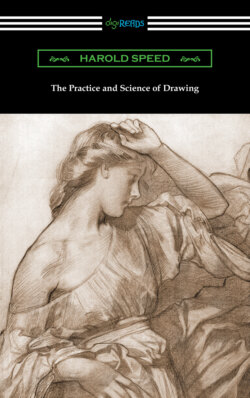Читать книгу The Practice and Science of Drawing - Harold Speed - Страница 9
На сайте Литреса книга снята с продажи.
ОглавлениеThe artist is capable of being stimulated to artistic expression by all things seen, no matter what; to him nothing comes amiss. Great pictures have been made of beautiful people in beautiful clothes and of squalid people in ugly clothes, of beautiful architectural buildings and the ugly hovels of the poor. And the same painter who painted the Alps painted the Great Western Railway.
The visible world is to the artist, as it were, a wonderful garment, at times revealing to him the Beyond, the Inner Truth there is in all things. He has a consciousness of some correspondence with something the other side of visible things and dimly felt through them, a “still, small voice” which he is impelled to interpret to man. It is the expression of this all-pervading inner significance that I think we recognise as beauty, and that prompted Keats to say:
“Beauty is truth, truth beauty.”
And hence it is that the love of truth and the love of beauty can exist together in the work of the artist. The search for this inner truth is the search for beauty. People whose vision does not penetrate beyond the narrow limits of the commonplace, and to whom a cabbage is but a vulgar vegetable, are surprised if they see a beautiful picture painted of one, and say that the artist has idealised it, meaning that he has consciously altered its appearance on some idealistic formula; whereas he has probably only honestly given expression to a truer, deeper vision than they had been aware of. The commonplace is not the true, but only the shallow, view of things.
“Art is the expression of the invisible by means of the visible”
expresses the same idea, and it is this that gives to art its high place among the works of man.
Beautiful things seem to put us in correspondence with a world the harmonies of which are more perfect, and bring a deeper peace than this imperfect life seems capable of yielding of itself. Our moments of peace are, I think, always associated with some form of beauty, of this spark of harmony within corresponding with some infinite source without. Like a mariner’s compass, we are restless until we find repose in this one direction. In moments of beauty (for beauty is, strictly speaking, a state of mind rather than an attribute of certain objects, although certain things have the power of inducing it more than others) we seem to get a glimpse of this deeper truth behind the things of sense. And who can say but that this sense, dull enough in most of us, is not an echo of a greater harmony existing somewhere the other side of things, that we dimly feel through them, evasive though it is.
But we must tread lightly in these rarefied regions and get on to more practical concerns. By finding and emphasising in his work those elements in visual appearances that express these profounder things, the painter is enabled to stimulate the perception of them in others.
In the representation of a fine mountain, for instance, there are, besides all its rhythmic beauty of form and colour, associations touching deeper chords in our natures—associations connected with its size, age, and permanence, &c.; at any rate we have more feelings than form and colour of themselves are capable of arousing. And these things must be felt by the painter, and his picture painted under the influence of these feelings, if he is instinctively to select those elements of form and colour that convey them. Such deeper feelings are far too intimately associated even with the finer beauties of mere form and colour for the painter to be able to neglect them; no amount of technical knowledge will take the place of feeling, or direct the painter so surely in his selection of what is fine.
There are those who would say, “This is all very well, but the painter’s concern is with form and colour and paint, and nothing else. If he paints the mountain faithfully from that point of view, it will suggest all these other associations to those who want them.” And others who would say that the form and colour of appearances are only to be used as a language to give expression to the feelings common to all men. “Art for art’s sake” and “Art for subject’s sake.” There are these two extreme positions to consider, and it will depend on the individual on which side his work lies. His interest will be more on the aesthetic side, in the feelings directly concerned with form and colour; or on the side of the mental associations connected with appearances, according to his temperament. But neither position can neglect the other without fatal loss. The picture of form and colour will never be able to escape the associations connected with visual things, neither will the picture all for subject be able to get away from its form and colour. And it is wrong to say “If he paints the mountain faithfully from the form and colour point of view it will suggest all those other associations to those who want them,” unless, as is possible with a simple-minded painter, he be unconsciously moved by deeper feelings, and impelled to select the significant things while only conscious of his paint. But the chances are that his picture will convey the things he was thinking about, and, in consequence, instead of impressing us with the grandeur of the mountain, will say something very like “See what a clever painter I am!” Unless the artist has painted his picture under the influence of the deeper feelings the scene was capable of producing, it is not likely anybody will be so impressed when they look at his work.
